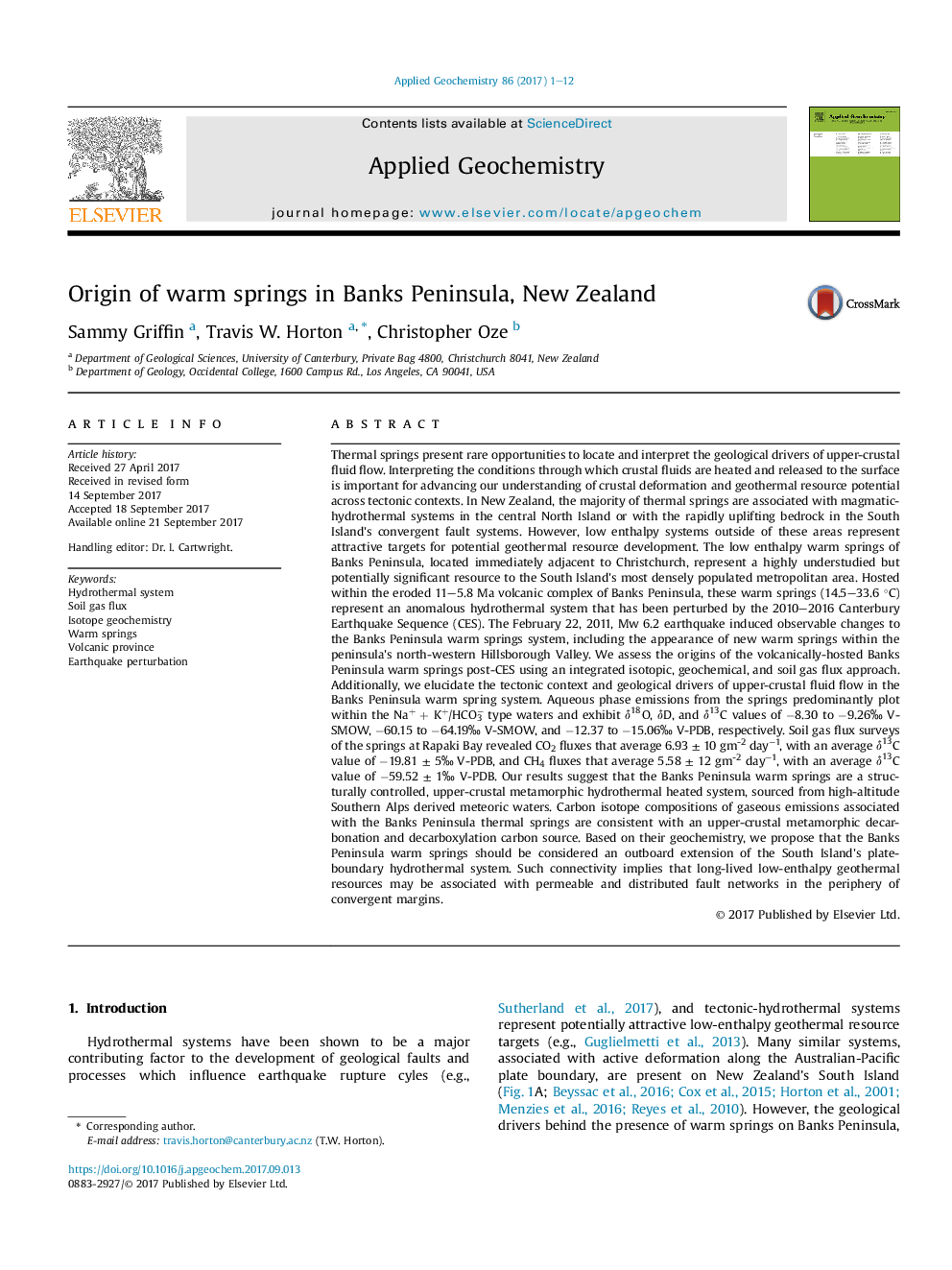| کد مقاله | کد نشریه | سال انتشار | مقاله انگلیسی | نسخه تمام متن |
|---|---|---|---|---|
| 5752469 | 1620206 | 2017 | 12 صفحه PDF | دانلود رایگان |
عنوان انگلیسی مقاله ISI
Origin of warm springs in Banks Peninsula, New Zealand
ترجمه فارسی عنوان
منبع چشمه های گرم در شبه جزیره بانز، نیوزیلند
دانلود مقاله + سفارش ترجمه
دانلود مقاله ISI انگلیسی
رایگان برای ایرانیان
کلمات کلیدی
سیستم هیدروترمال، جریان گاز خاک، ژئوشیمی ایزوتوپ، چشمه های گرم استان ولکانیک، اختلال زلزله،
موضوعات مرتبط
مهندسی و علوم پایه
علوم زمین و سیارات
ژئوشیمی و پترولوژی
چکیده انگلیسی
Thermal springs present rare opportunities to locate and interpret the geological drivers of upper-crustal fluid flow. Interpreting the conditions through which crustal fluids are heated and released to the surface is important for advancing our understanding of crustal deformation and geothermal resource potential across tectonic contexts. In New Zealand, the majority of thermal springs are associated with magmatic-hydrothermal systems in the central North Island or with the rapidly uplifting bedrock in the South Island's convergent fault systems. However, low enthalpy systems outside of these areas represent attractive targets for potential geothermal resource development. The low enthalpy warm springs of Banks Peninsula, located immediately adjacent to Christchurch, represent a highly understudied but potentially significant resource to the South Island's most densely populated metropolitan area. Hosted within the eroded 11-5.8 Ma volcanic complex of Banks Peninsula, these warm springs (14.5-33.6 °C) represent an anomalous hydrothermal system that has been perturbed by the 2010-2016 Canterbury Earthquake Sequence (CES). The February 22, 2011, Mw 6.2 earthquake induced observable changes to the Banks Peninsula warm springs system, including the appearance of new warm springs within the peninsula's north-western Hillsborough Valley. We assess the origins of the volcanically-hosted Banks Peninsula warm springs post-CES using an integrated isotopic, geochemical, and soil gas flux approach. Additionally, we elucidate the tectonic context and geological drivers of upper-crustal fluid flow in the Banks Peninsula warm spring system. Aqueous phase emissions from the springs predominantly plot within the Na+ + K+/HCO3â type waters and exhibit δ18O, δD, and δ13C values of â8.30 to â9.26â° V-SMOW, â60.15 to â64.19â° V-SMOW, and â12.37 to â15.06â° V-PDB, respectively. Soil gas flux surveys of the springs at Rapaki Bay revealed CO2 fluxes that average 6.93 ± 10 gm-2 dayâ1, with an average δ13C value of â19.81 ± 5â° V-PDB, and CH4 fluxes that average 5.58 ± 12 gm-2 dayâ1, with an average δ13C value of â59.52 ± 1â° V-PDB. Our results suggest that the Banks Peninsula warm springs are a structurally controlled, upper-crustal metamorphic hydrothermal heated system, sourced from high-altitude Southern Alps derived meteoric waters. Carbon isotope compositions of gaseous emissions associated with the Banks Peninsula thermal springs are consistent with an upper-crustal metamorphic decarbonation and decarboxylation carbon source. Based on their geochemistry, we propose that the Banks Peninsula warm springs should be considered an outboard extension of the South Island's plate-boundary hydrothermal system. Such connectivity implies that long-lived low-enthalpy geothermal resources may be associated with permeable and distributed fault networks in the periphery of convergent margins.
ناشر
Database: Elsevier - ScienceDirect (ساینس دایرکت)
Journal: Applied Geochemistry - Volume 86, November 2017, Pages 1-12
Journal: Applied Geochemistry - Volume 86, November 2017, Pages 1-12
نویسندگان
Sammy Griffin, Travis W. Horton, Christopher Oze,
